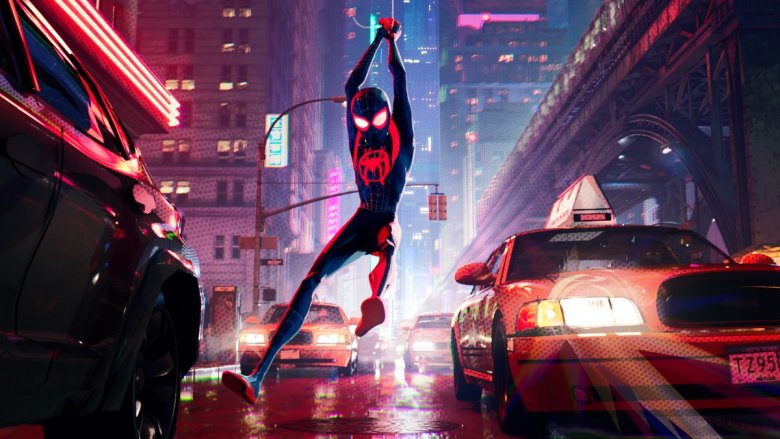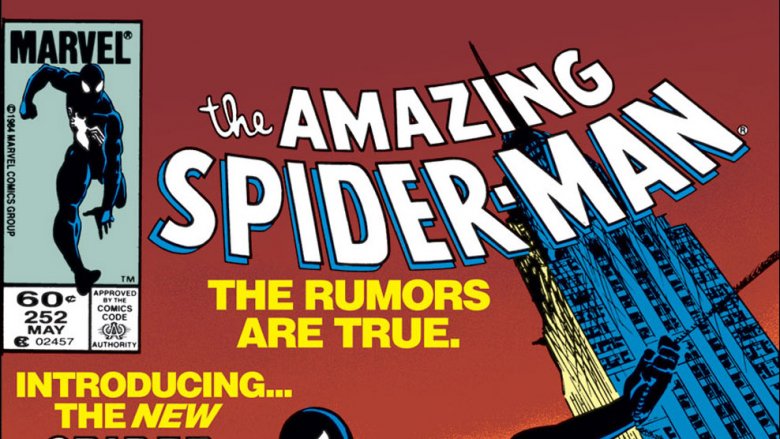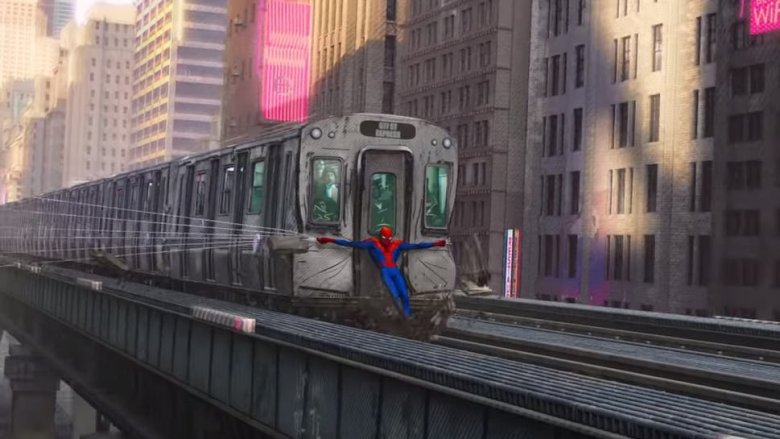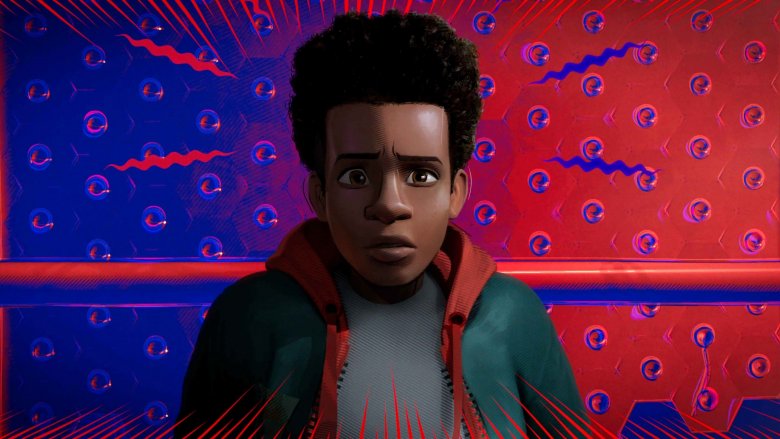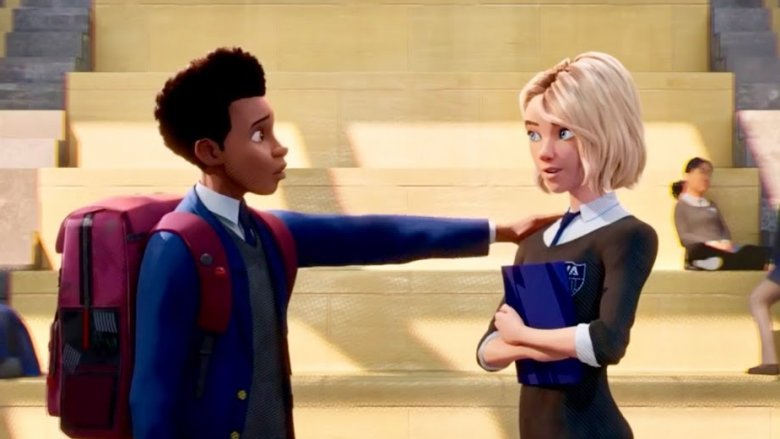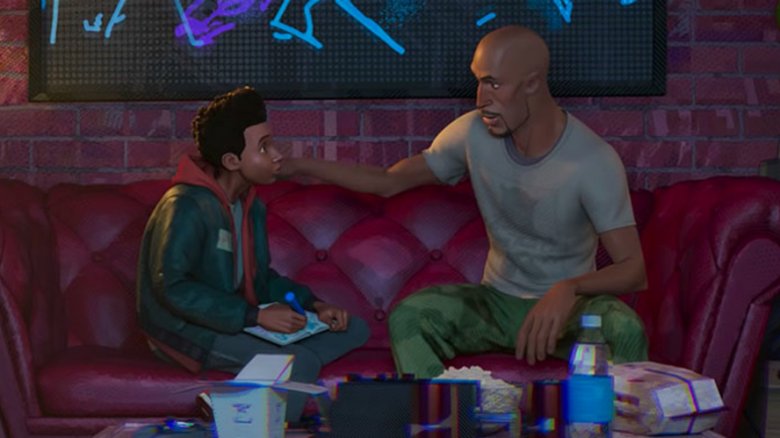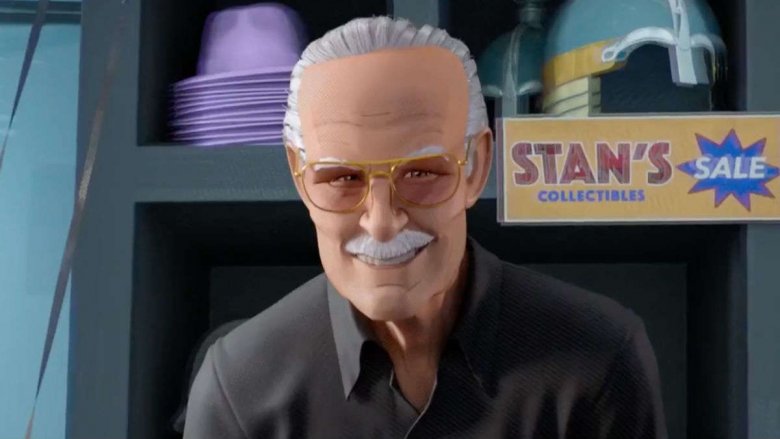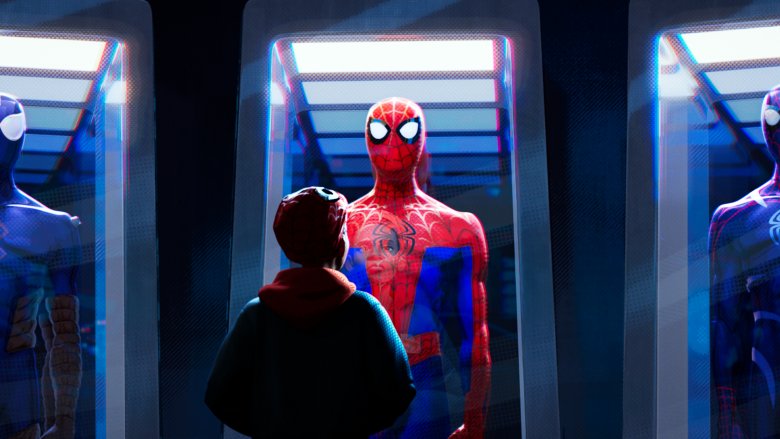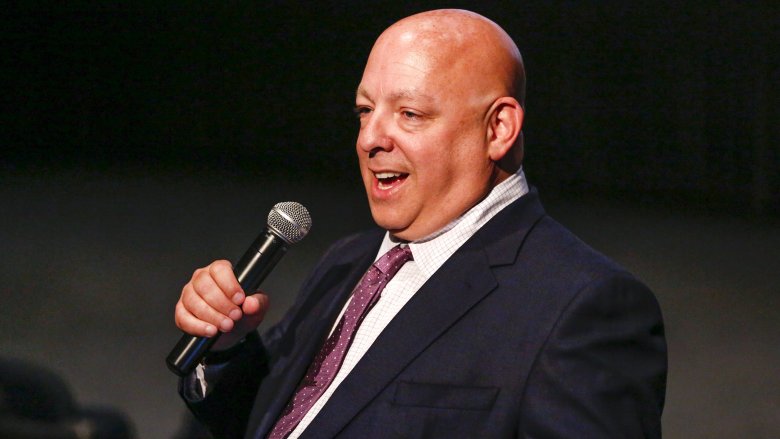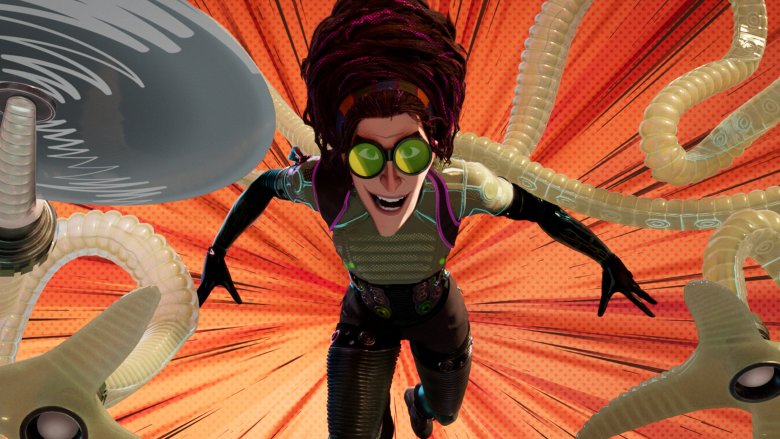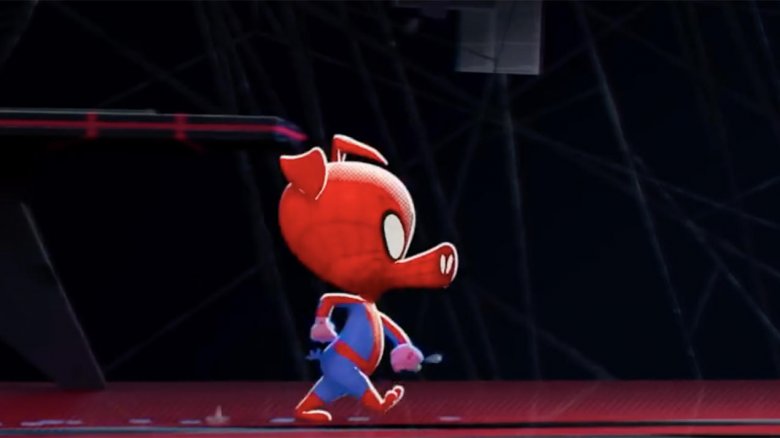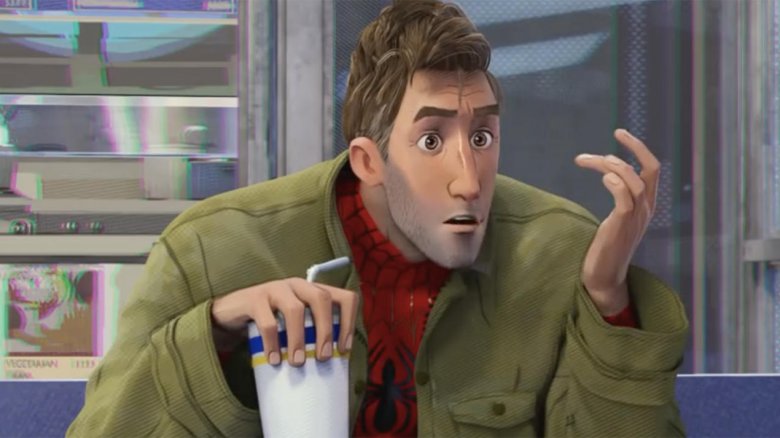Spider-Man: Into The Spider-Verse Details That Only Adults Notice
If you re-watch a classic Disney animated film from your childhood as an adult, you're almost guaranteed to pick up on something that you didn't understand as a kid. Sometimes it's a joke, like Hercules' comments about Oedipus "having problems," or sometimes it's some not-so-subtle hidden imagery that a youngster is sure to miss.
It's no secret that the best kids' movies often have ample scenes, jokes or dialogue that target the parents and older viewers in the audience — after all, they're more often than not the ones who paid for the tickets! A successful family film has elements that all ages can appreciate, even if the main characters are childish cartoons.
Such is the case with Spider-Man: Into the Spider-Verse, 2018's Oscar winner for best animated feature film. Phil Lord and Christopher Miller's trippy, innovative, and wonderfully bizarre experiment plays like a comic book come to life. It's a genuine feat in animated cinema. While the movie is arguably most suitable for children, it has some truly great moments that it takes an older viewer to fully appreciate — and with that in mind, we've rounded up some of the most noticeable things that only adults will notice. Spoilers for Spider-Man: Into the Spider-Verse follow.
Approved by the Comics Code Authority
It doesn't take long for the film to treat audiences to a throwback reference. As the opening credits are rolling, an old-timey stamp appears on the screen, declaring the movie as "Approved by the Comics Code Authority." For youngsters in the audience, this seal of approval might as well have been another production company's logo. For seasoned adults, however, it meant something much more.
In the 1950s, The CCA (Comics Code Authority) was formed in response to the often perceived violence and horror that arose in comic books. For nearly 60 years, this seal of approval was printed on the front pages of comics, ensuring readers (and perhaps more importantly, the parents of readers) that the stories and images within the books were safe for their eyes. According to Bleeding Cool, Marvel stopped using the seal in 2001, choosing instead to utilize their own rating system. Still, this was a humorously nostalgic blast from the past for the adults in the audience.
A very meta intro
Into the Spider-Verse feels like a movie that is fully aware of the fact that it's inspired by a comic book. The film begins with an introduction from Peter Parker... well, A Peter Parker, as we later meet a couple different versions of him. If you pick up on the context clues, you can determine that the Peter from the beginning of the film is actually Tobey Maguire's Spider-Man from the original Sam Raimi trilogy. The film smartly displays animated versions of scenes from those movies, including Peter stopping the runaway train in 2004's Spider-Man 2 and even his weird dance from 2007's Spider-Man 3. Rumor has it that Sony actually even considered casting Maguire to voice this version of Parker before ultimately settling on Chris Pine.
Beyond that, Peter goes on to brag that he's been featured on a slew of various merchandise, including a comic book, a cereal, and even a "so-so Popsicle." He also mentions that he has "an excellent theme song," which fans of the early animated cartoon shows can certainly vouch for. While this surplus of Spidey stuff is sure to give older fans fits of nostalgia, you have to wonder how much of it went unnoticed by the younger generation.
Does that seem blurry to you?
If you go see Into the Spider-Verse with someone who isn't an avid comic book reader, you might have heard them question why, at times, the animation looks a tad off. There are several scenes when items or colors are noticeably misprinted, making it look almost like an error. Believe it or not, this was actually done on purpose.
According to Business Insider, Lord and Miller decided to use this "misprint style" to create a depth of field, making the items in focus appear crispier. This makes watching the movie feel like you're literally watching a comic book in motion. As the Los Angeles Times puts it, "The color shift and the dot-based halftone effect contributed to the more (sometimes imperfect) comic-book look of the movie." While kids in the audience can appreciate the film's cool, unique artwork, only the older generation will comprehend why the animation at times looks like a misprint.
It's a puberty thing
After Miles is bit by the radioactive spider, his body starts to change. He wakes up the next morning and notices that his pants are now too short because he grew in height. Seeking an explanation, he wonders if he's possibly going through puberty.
Later, he finds himself noticeably sweating while trying to pull off Uncle Aaron's "shoulder touch" pick-up move with Gw-anda (Gwen). When she questions his immense perspiration, he tells her: "It's a puberty thing." He continues to stick with this story throughout the scene, even when his newly acquired spider-grip gets stuck in Gwen's hair, causing her to exclaim, "I don't think you know what puberty is!"
The scene is humorous to adults because they know that obviously puberty has nothing to do with gaining spider powers. However, for a kid who hasn't gone through puberty, they might not fully grasp the outlandish nature of Miles' assessment. If only it truly did grant you superpowers!
Uncle Aaron was doomed from the start
You don't have to be Sherlock Holmes to immediately figure out that in Into the Spider-Verse, Miles' Uncle Aaron was going to play an important role in the young hero's story. Fans of the comics knew that he was actually the Prowler, but even if you didn't know that going in, it became pretty obvious early on that good ol' Uncle Aaron had a few tricks up his sleeve, such as when he acrobatically makes short work of a chain link fence in the subway tunnels.
However, when you consider that this is a Spider-Man movie, the term "uncle" should be a red flag. Everyone knows that it took the death of his Uncle Ben for Peter Parker to realize that his actions have consequences, and that he can't always save everyone; for young Miles, it's the death of his Uncle Aaron. The parallel between the two characters is a brilliant facet of the film that is very mature and thought-provoking, most likely only noticed by those in the audience who were really looking for it.
We all miss you, Stan
On November 12, 2018, the comic book community was dealt a blow as news broke that the legendary Stan Lee had passed away at the age of 95 due to respiratory and congestive heart failure. Lee, who was a pillar of the Marvel Comics brand, was credited with creating and co-creating countless popular characters, including Iron Man, Black Panther, The Incredible Hulk, and Spider-Man.
He was also quite famous for the small appearances he made in Marvel's movies and TV shows, starting as far back as 1989's The Trial of the Incredible Hulk. "Stan the Man" was the Michael Jordan of cameos, and not even death could stop him from appearing in Marvel movies, as evidenced by his posthumous brief role in Into the Spider-Verse.
In the film, Lee plays a cashier at the store that Miles buys his Spider-Man suit from after the death of his universe's Peter Parker. In a surprisingly tear-jerking scene, Stan Lee gives some incredibly poignant dialogue about Spider-Man's passing: "I'm going to miss that guy. We were friends, you know." While Lee had become a very well-known figure in pop culture, you have to assume that only adults fully appreciated the emotional magnitude of the scene.
This place is pretentious
After a close shave with Fisk and Doc Ock, Miles, Gwen and Peter B. Parker head to Aunt May's house for sanctuary. After a touching reunion, she takes them out back to a mysterious shed, revealing Peter's secret "spider lair." The scene is chock full of various Easter eggs and nods to Spider-Man gizmos and gadgets from past comics and movies. Nerdist reports that "almost every alternate Spider costume is on display, including the Iron Spider Armor from Civil War, the Secret Wars costume, the stealth suit, a variation on the Scarlet Spider suit, and the recent Sony PS4 game gets a nod too."
The hideout also includes the infamous Spider Buggy, a Jeep-like vehicle that Spider-Man drove in the '70s, and even the Spider-Cycle, which originated in the '90s television show Spider-Man: The Animated Series. While children viewing this scene surely got a kick out of the awesome overabundance of Spider-Man memorabilia, a lot of the props originated in the '90s and early 2000s, before their time. Only a full-grown comic book nerd will be able to identify all of the nostalgic references in this scene.
New phone, who dis?
Eagle-eyed audience members most likely picked up on a hearty portion of the various Easter eggs featured in Spider-Man: Into the Spider-Verse. In one of the film's many blink-and-you-miss-it moments, viewers get a peek at Jefferson Davis' phone contacts. Although Davis is trying to call his brother, Aaron Davis, you can't help but notice another, more prominent name on the list: Steve Ditko. Marvel fanboys will recognize that as a nod to Steve Ditko, the comic book artist who, along with Stan Lee, co-created Spider-Man and Doctor Strange.
However, the subtle name-dropping doesn't stop there. In another scene, Miles takes out his phone to make a call, and the audience yet again gets a glimpse at his phonebook. The most obvious attention-grabbers are the names B. Bendis (alluding to Brian Michael Bendis) and Sara Pichelli. This duo co-wrote Miles Morales' first series, 2011's Ultimate Comics Spider-Man. You probably only noticed these subtle details if names like Ditko, Bendis and Pichelli meant something to you, and for many comic readers in the '90s and early 2000s, that was the case.
A dangerous assumption
Into the Spider-Verse is ripe with humor targeted at adults. Perhaps the most memorable example arises when Peter B. Parker is laying out his plan to break into an evil lab. He assumes that the head scientist is a man, but in reality, she is a woman (as the audience comes to learn, she's actually Olivia Octavius, this universe's Doc Ock). When Miles corrects him, Peter changes his step to "Re-examine my personal biases."
Jake Johnson delivers the line with such deadpan sarcasm that it is honestly one of the funniest scenes in the movie. However, it's a joke that is really geared towards an older demographic. Most kids are too young to comprehend what a personal bias is, or why the joke is so timely. This is probably a scene in the movie that kids will laugh at because they see their parents laugh, while actually not understanding the joke.
Porker quotes Porky
When it's finally his turn to return to his own universe, John Mulaney's Peter Porker, a.k.a. Spider-Ham, gives Miles a touching farewell, humorously gifting him a massive wooden hammer ("I want you to have this; it'll fit in your pocket") before making the jump home. Right before he falls, he sadly declares, "That's all, folks," prompting Peter B. Parker to ask, "Is he allowed to say that? Legally?"
The line is obviously a reference to the Looney Toons character Porky Pig, owned by Warner Bros. — who you can assume has a trademark on the infamous phrase. By questioning the legality of using the line, Peter B. Parker basically breaks the fourth wall to make sure the audience realizes the comedic insanity of the situation. To have a cartoon pig that isn't Porky saying "That's all, folks" is a meta nod to a competitor's classic character. The humor of the scene is lost on children, however, because they probably don't understand copyright infringement.
Do I want kids?
Into the Spider-Verse really starts to gain traction when Peter B. Parker enters the fold — a chubbier, more depressed Spider-Man than the one from Miles' universe. During his introductory scene, the audience learns that this more jaded, broken-down version of Peter broke up with Mary Jane because she wanted kids, a prospect that scared him. Although it's presented in a humorous light, with shots of Peter crying in the shower and eating copious amounts of pizza, this theme of Peter learning that he can, in fact, become a good parent is present throughout the movie, for those clever enough to pick up on it.
It doesn't take a rocket scientist to realize that the relationship between Peter and Miles is not unlike that of a father and son. Miles, the in-over-his-head apprentice, seeks guidance from Peter, the weary master who is so experienced that he almost can't help himself from giving advice. By the end of the movie, Peter gets to witness firsthand the effect his presence had on Miles' heroic growth, and it's a feeling that gives him immense pride. In the climactic final battle, Peter even questions aloud, "Do I want kids?" Most parents in the audience surely understood Peter's weighty realization.
